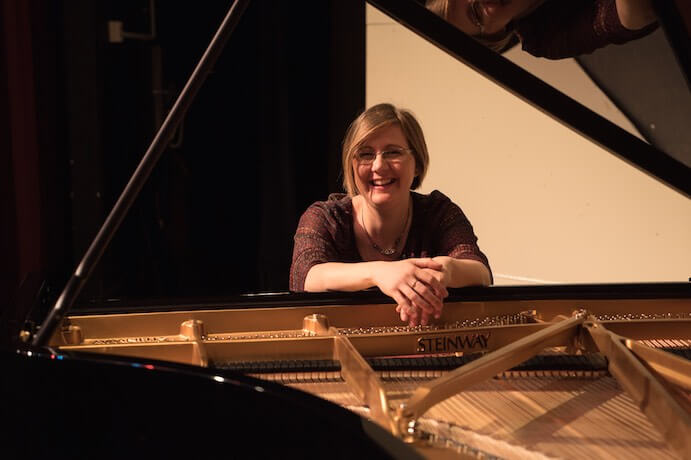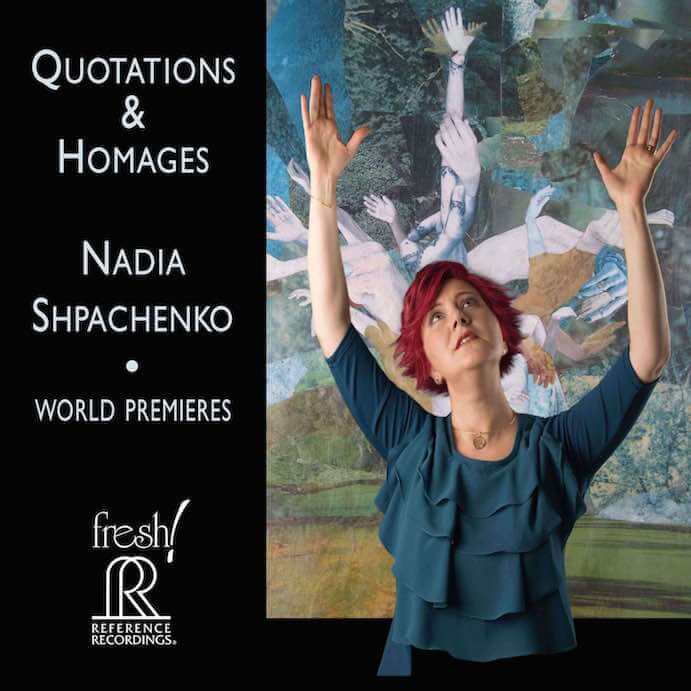When a new CD to review arrives from ICIYL Central, the first thing I do is put in the player and then go about my business. If the CD becomes mere background then it has some work to do to convince me of its merit. But if it grabs me and immediately pulls me into its sound world, I know we have a winner–and yes, Nadia Shpachenko‘s new Reference Recordings album Quotations and Homages is a clear winner.
Coming on the wings of her Grammy-nominated album Woman at the New Piano: American Music of 2013, also on Reference Recordings, Quotations and Homages showcases Shpachenko’s prodigious pianism and her ability to conceive and execute innovative and accessible programs. As the title suggests, the compositions on the album pay tribute to and quote composers ranging from Bach to Ustvolskaya. Shpachenko compares her program to a “rummaging process” through hand-me-down clothes: reimagining, trying new things, recycling, tossing out. Most of the nine works on the program were commissioned by or dedicated to Shpachenko, and all amazingly fit together in a cohesive, yet ever-shifting whole.
Take for example the captivating first piece on the program, Rainbow Triangle for piano and electronics, which was written for Shpachenko by Tom Flaherty. Based on a short passage from Quatuor pour le fin du temps, this dense, colorful, and imaginative work evokes Messiaen’s exotic and mystic style. No mere recycling of Messiaen, this work stands alone as an ear-catching reimagination of the material. The electronics (reverberation and transpositions mostly) add a subtle otherworldly atmosphere, and Shpachenko’s technique and interpretation are above reproach.

Nadia Shpachenko–Photo by Max Cheung
Another “grabber” is Nick Norton‘s Piano Piece for Mr. Carter’s 100th Birthday, although coming in at less than 15 seconds, it seems hardly worth mentioning. But as with Eliott Carter, a lot of music and ideas are crammed into these fleeting seconds. Shpachenko tosses it off with flair and jaw-dropping technique. Don’t let this one pass by unnoticed.
Norton’s dramatic whirlwind contrasts with Adam Borecki‘s ironic and light-hearted Accidental Mozart based on the familiar theme from Mozart’s Sonata for Piano No. 16, K. 545. Each of the eight variations is paired with an alcoholic beverage. For example, the first variation is paired with a gin and tonic, and is to be played “quaint and simple.” The last variation is a Bloody Mary “or other hangover cure.” Far from just a whimsical “wrong note” reworking of the theme, Accidental Mozart is imaginative and amusing, just the tonic one needs after the far more intense proceeding works.
Missy Mazzoli‘s Bolts of Loving Thunder (2013, rev. 2016) was written for Emanuel Ax and is based on Brahms’ “frei aber froh” (free but happy) F-A-F motive, which can be heard throughout his works. Mostly tonal and flowing, Bolts of Loving Thunder is more than imitation Brahms–its power captures the storms and passions of Romantic music in a quite contemporary way. Shpachenko negotiates this dense work with ease, each climax more thrilling than the previous.

Missy Mazzoli– Photo by Stephen Taylor.
Vera Ivanova‘s 6 Fugitive Memories is a masterful suite of vignettes inspired by a range of composers from Debussy and Satie (wonderfully commemorated in the delicate final movement “Debutie”) to Prokofiev, Kurtág, Ustvolskaya, and on to Feldman. Even with such diverse inspiration, the six pieces work wonderfully together in an organic flow. “No N” conjures the quiet, reflective almost static sound of Feldman, while “Cimbalom Játék” is dedicated to Kurtág, who often used the cimbalom (the national folk instrument of his native Hungary) in his works. Shpachenko recreates the distinctive sound of the cimbalom using a dulcimer hammer on the strings to great effect.
Less successful is Peter Yates‘ Epitaphs and Youngsters, a melodrama for solo pianist inspired by Bach, Gershwin, de Falla, and Glenn Gould. Even with Shpachenko’s clear and articulate vocals, the work is static in nature, lacking the rhythmic drive and spontaneous inspiration of its disc mates.
Daniel Felsenfeld‘s Down to You is Up is the oldie among the selections, written in 1998 but revised in 2015, and is the only work inspired by rock music. Taking the music of the ’70’s band The Velvet Underground, Felsenfeld weaves a three-movement fantasia around three of the group’s most memorable songs. The work, aided by Shpachenko’s committed and crisp playing, captures the power and rhythmic drive of rock along with its inherent lyricism and harmonic complexity.

Daniel Felsenfeld
Joining Shpachenko for the last two works on the album are her collaborator from Woman at the New Piano Genevieve Feiwen Lee, plus Vicki Ray, Aron Kallay, and the HOCKET duo (Sarah Gibson and Thomas Kotcheff).
James Matheson‘s Bagatelle must be as fun to watch as it is to hear. Scored for six pianists on three pianos, Bagatelle takes a theme from Beethoven’s “Eroica” symphony on a 4-minute kaleidoscopic ride. Never overbearing, Matheson uses his forces to stretch and deconstruct the familiar theme, ending with the motif in its original form surrounded by fanfares from the other pianists. This was one of the highlights of the disc for me.
Tom Flahtery brings the album to a satisfying close with his Igor to Please for six pianists on two toy pianos, two grand pianos, and electronics. The toy pianos are used as texture, and the electronics provide subtle but effective color, resulting in an almost Asian mood surrounded by flashes of Stravinsky’s trademark rhythms and harmonies. Not really a derivative of Le Sacre but a screenshot of the background and mood of the piece, Igor to Please does please the ear and challenges as well, capturing the sounds and visceral feel of pagan folk music, the Asian colors adding to the exotic atmosphere.
- If anything, Quotations and Homages is even more absorbing, creative, and entertaining than Woman at the New Piano. The album is a fascinating and approachable glimpse into the music of then and now realized through the hands and mind of a most interesting and dedicated musician. Usual state-of-the-art Reference Recordings sonics and informative notes on the works, composers, and performers completes the package.





















